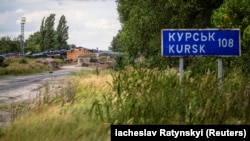The middle-aged man, who mostly lives and works in Russia, came to Armenia three weeks ago to visit his relatives, leaving behind a family in the Kursk region, which has seen a major incursion by Ukrainian armed forces since August 6.
Advancing Ukrainian soldiers have captured dozens of towns and villages in the Kursk region, causing tens of thousands of local civilians to flee their homes. This cross-border action by Ukrainian forces comes after more than two years of Russian aggression against Ukraine, where thousands of civilians, including many children, have been killed.
The Kursk region is home to more than 5,000 ethnic Armenians, making them the second largest ethnic minority in the region after Ukrainians.
But many more Armenians like Mkhitarian are known to regularly travel to Russia, including its Kursk region, as migrant workers.
“I will go back there to join my family. Then we will decide what to do next,” he said.
The man said he is in constant touch with other members of his family who, he said, so far have not been directly affected by the fighting. “They said that [Russian] troops have arrived and are stationed in the Kursk region where there is a nuclear power plant that needs defending. That’s why there is strong defense there,” he said.
Mkhitarian acknowledged that the ongoing conflict might make his journey back to Kursk “a little longer.” “We will travel by car, choosing a route to bypass the areas where there may be fighting,” he said.
Another family from Voskehat with relatives in Kursk told RFE/RL’s Armenian Service that they considered returning to Armenia but were concerned about their adult sons who might be restricted from leaving the country due to their draft age.
A woman named Alina, whose husband’s relatives are in Kursk, said they regularly spoke on the phone, but her most recent attempt to reach them via video call failed. She said the last time they spoke her relatives told her about sounds of explosions nearby and said that they were facing a “tough choice” of whether to stay or leave everything behind and move out.
“They even thought about coming to Armenia, but since their sons are Russian citizens and are over 30 years old, they fear they would not be allowed to leave,” Alina said.
“They told me about an incident in which a bomb fell on a car parked outside a residential building wounding a lot of people and a sugar plant that was blown up, which is a big problem ahead of the upcoming harvesting season,” the woman added.
Derenik Kostanian, leader of the Armenian community of Russia’s Kursk region, told RFE/RL’s Armenian Service that while there was no fighting in the city of Kursk itself, many people had been arriving from nearby areas affected by the conflict.
He noted that most of the displaced people come from Suja, a border town that Ukrainian forces claim to have fully captured, as well as nearby villages. According to Kostanian, around 150 ethnic Armenians have also been displaced by the fighting.
It remains unclear whether the Armenian government plans to assist in the evacuation of Armenian citizens or ethnic Armenians from Kursk to Armenia. Kostanian said that he regularly updated representatives of the Armenian embassy in Moscow on the situation in the Russian region.

Facebook Forum